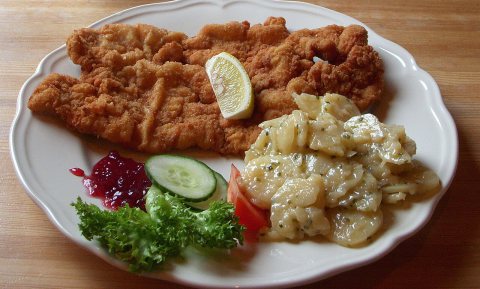Campylobacter en salmonella
Ik vertelde De Gelder dat ik weleens zou willen weten of de Amerikaanse chloorkip minder campylobacter en minder salmonella-besmettingen kent dan de onze. Nederlandse kip heeft immers een vervelend hoge besmettingsgraad die voorkomen zou kunnen worden met een zuur- of een chloorbad. Een deel van die besmetting wordt overigens - ook in Nederland - tegengaan met chloor en chloordioxide in het drinkwater van de kip. Ik hoopte dat Van Gelder de vraag mee zou nemen naar zijn andere gesprekspartners.
'Veel viezer'
Helaas. Volgens Hugo Hooijer van Milieu Defensie hebben de Amerikanen 'veel viezere kip' dan wij. Hij zegt dat we in Europa een veel schonere kip hebben. Waarom dat zo is, onderbouwde hij niet. Volgens kippenvoorman Oplaat hebben wij een betere kip en hoeft er niet met chemische middelen gewerkt worden om die veilig bij de consument te krijgen. Volgens Zwietering is ontsmetting van kip helemaal geen verkeerd idee, al blijven er altijd wat bacteriën over. Maar hoe het nou echt zit, kwam niet aan de orde.
Als dat zo is, moet geconstateerd worden dat Amerikanen aanmerkelijk veiliger kip eten dan wij met - het woord is van De Gelder - wat misschien ook wel een goorkip isHoe zit het echt?
Help voedselveiligheidsmensen: vertel ons hier hoe het echt zit. Ik las in een stokoud wetenschappelijk artikel van S.M. Shane uit 2000 dat ontsmetten vermoedelijk een goed idee is. Ik weet ook dat wij ons besmettingsniveau maar niet omlaag krijgen. In dat artikel staan keurige vergelijkingen tussen besmettingsniveau's in verschillende landen. Daarna vind ik die niet zo makkelijk meer, terwijl Nederland bepaald niet in de categorie 'betere kiplanden' blijkt te vallen.
Daarom toch maar die vervelende vraag: is het wellicht zo dat Amerikaanse kip beter scoort op zowel salmonella als campylobacter?
Als dat zo is, moet geconstateerd worden dat Amerikanen aanmerkelijk veiliger kip eten dan wij met - het woord is van De Gelder - wat misschien wel op z'n minst ook een goorkip is. Salmonella en campylobacterbesmettingen zijn bepaald geen feest. Niet voor niets sprak vorig jaar Franz Daschner, een Duitse voedselveiligheidskenner, zich nadrukkelijk pro-chloorkip uit. Dat was niet makkelijk voor hem, want de Duitse consument werd als eerste tegen de chloorkip in stelling gebracht door actievoerders. Toch vond hij het nodig om zich impopulair te maken.
Waar we het toch niet over kunnen hebben
Onderwijl blijft onze minister Ploumen vertellen dat de chloorkip er echt niet in komt. Een Amerikaan wist in Nieuwsuur helder te vertellen dat het eigenlijk alleen maar gaat om het feit dat wij Europeanen ISDS in de grond van de zaak niet snappen en dat komieken en actiegroepen ons ermee isoleren, zodat we het niet meer kunnen hebben over wat wij nu echt willen:
1. als Europa een eigen rol spelen in de wereld, los van de VS
2. als Europa een rol spelen als vazal van de VS (die ons al langere tijd niet meer zien als partner door dik en dun)
3. als Europa een rol spelen met machtsblokken (en enorme zich ontwikkelende economieën) die zich ten Oosten van de EU bevinden, maar (ver) buiten onze culturele identiteit vallen
Over die drie uiterst wezenlijke vragen zouden we het moeten hebben. Maar dat kunnen we dankzij komieken en actieorganisaties in Europa niet meer. Wij hebben het liever over chloorkip. Laten we ons daar op Foodlog dus ook vooral toe beperken. Voedselveiligheidskenners: help!
Fotocredits: still, Lubach/VPRO
Op 3 augustus krijg je nieuwe kado-artikelen.
Als betalend lid lees je zoveel artikelen als je wilt, én je steunt Foodlog












Waarom doet AH niet wat Coop in Denemarken wél deed?
"Co-op Denmark told suppliers that it would not buy their chicken meat if they did not enact measures to curb Salmonella.
The retailer, with nearly 40 percent of the market, told suppliers they had to destroy flocks that had a positive test prior to slaughter. Co-op Denmark also required companies to test a sampling of butchered meat. If any positives popped up, meat from that flock was rejected."
"“They thought it would pass,” Froidt said. “But then we introduced Swedish broiler meat, which at the time had a lower incidence of Salmonella. They found out we were serious.”
The retailer dangled an incentive, introducing a “Salmonella-free” label on raw chicken from companies that complied. That label carried cachet with consumers and fetched a higher price."
"Goorkip" blijkt dus gewoon onnodig, en zelfs chloor-of azijnkip blijkt onveilig als in het voortraject elementaire hygiëne niet in acht genomen wordt, volop kruisbesmetting plaats vindt, en onvoldoende gecontroleerd wordt op pathogenen.
Waarom kan AH als 's lands bij verre grootste kipverkoper niet wat Coop en Denemarken na 2007 wél is gelukt: Salmonellavrije kip, die ook op andere pathogenen stukken beter scoort dan de kip die nu in onze schappen ligt.
Hoeveel onnodige besmettingen, ziekenhuisopnames en zorgkosten had dat ons niet kunnen besparen?
"The trouble with chicken": ook chloreren blijkt niet afdoende. Een kwart van de kip van Foster Farms, een van de grootste kipfabrikanten in de VS, blijkt toch nog Salmonella te bevatten, waaronder ook multiresistente Salmonella Heidelberg. Omdat zelfs die niet "food adulterant" is verklaard, zijn recalls pas mogelijk na een 1-op-1 link tussen de pathogenen in een (kip)product en daardoor besmette zieke. Daardoor kon het meer dan een jaar en honderden ziekenhuisopnames duren eer Foster Farms besmette kipproducten terugriep.
Dit is wat ons met dat TTIP onder meer te wachten staat: producenten kunnen landen buiten onze reguliere rechtspraak om, middels ISDS-arbitrage aanklagen wegens vermeende verstoring van winstpotentieel. De NVWA even tandeloos als de USDA en de ISDS.
En zelfs die chloorkip blijkt dus lang niet zo veilig als beweerd.
Evenmin als dat "goed doorbakken" overigens zo effectief is als verwacht, blijkens onderzoek van WUR-professor Zwietering:
"Extreme Heat Resistance of Food Borne Pathogens
Campylobacter jejuni, Escherichia coli,andSalmonella
typhimuriumon Chicken Breast Fillet during Cooking".
De enige oplossing lijkt toch echt een andere wijze van dieren houden: hygiënischer werken vanaf de start van het productieproces. Dat dat mogelijk is, laten de Denen zien met hun Salmonellavrije kip. In Zweden produceert men varkensvlees zonder MRSA, en worden stallen met MRSA geruimd.
Ook dat blijkt dus gewoon mogelijk.
Ook Obama stelt overigens voor om de gefragmenteerde keuringsinstanties onder te brengen bij "VWS", terwijl consumentenorganisaties een volledig onafhankelijke Amerikaanse NVWA bepleiten. Bij ons hangt de NVWA zelfs nog steeds onder EZ.
P.S.: Harold, inderdaad is de monstername belangrijk: men testte bij Foster voornamelijk kipkarkassen, en niet de kipdelen, die in de fabriek besmet raakten.
Nog enkele interessante statische feiten uit de VMT van 24 april, van de de (Salomella) kip expert Jaap Obdam:
"Het vinden van Salmonella wordt voor 20 procent bepaald door het lab en 80 procent door monstername."
"We hebben bijna 300 negatieve monsters nodig om met 96 procent zekerheid te kunnen stellen dat het besmettingsniveau van een koppel lager is dan één procent."
Kortom 0 bestaat niet en al helemaal niet zeker!
Lourens, dank!!! En tevens aan Prof. Wigley!
Hierbij de antwoorden op de vragen van Boyd Berends (#30) zoals beantwoord door prof. Wigley van veterinaire faculteit aan univ. Liverpool. Men leze nummersgewijs de vragen van Boyd Berends, en vervolgens de antwoorden van Paul Wigley:
In response. It is important to remember I am not a clinician/public
health vet or an epidemiologist. I am primarily interested in the biology
of the bacteria. Some of our recent relevant work is attached:
1) To what extend does this invasion of deep muscle invasion of apply to
campylobacter. To my best of my knowledge is does not.
Wigley:
We have found this recently from commercial production, it is infrequent
and seems associated with a few sequence types. It is in a PhD thesis,
Camilla Brena, Liverpool 2014 but this is currently embargoed for public
release. We have also infected chickens with some of these isolates and we
get muscle contamination, albeit infrequently. This work is being prepared
for publication
1b)Can you indicate to what extent the invasion of the (bile ducts) the
liver with Campylobacter has an impact on the safety of the chicken
carcass and / or the biocidal effect of lactic acid on that carcass?
1c) Can you, in a quantitative sense indicate the extent to which the
invasion of the liver with Campylobacter leads to infections in humans.
Wigley:
It is more than bile duct contamination-there is clear spread which may be
associated with invasion. The level of liver infection is variable and
highly dependent on the isolate (please see attached paper). As above we
are currently working on a paper that looks at a number of isolates-we
find liver contaminate is between 10-60% of experimentally infected
animals dependent on the breed and isolate.
The amount of human disease directly attributable to liver is hard to say.
Certainly we are aware that chicken liver pate is the single largest risk
factor in the UK and liver is responsible for most outbreaks as compare to
sporadic cases
2) If it is only salmonella, then gladly specify which tissues is meant?
This invasion in otherwise clinically healthy animals (ie not suffering
from blood poisoning/sepsis) is one of the subjects that I have done
research and I have not found otherwise than positive lymph nodes that
were associated with the gastrointestinal tract (as to say the almonds,
and the mesenteric lymph nodes and such) and not elsewhere in the body
(for example in the armpits or the knee). I neither encountered positive
muscle meat (deep inside, so, of course, not at the surface). In the
sixties, however, there have been a few East Germans who isolated
Salmonella from the deeper muscle layers of ham. However, this is a
case-report, so that it says nothing about the impact at the population
Level.
Wigley:
First-chickens do not have lymph nodes. Salmonella is commonly found in
spleen and liver at low levels in apparently healthy chickens prior to
immune clearance. Levels of spread to other tissues are variable, though
intestinal contamination of meat is the highest risk. Of course lymph
nodes would be a big issue in pigs.
3) If you have such data in any journal or report, were is this published?
Wigley:
There are hundreds of papers of experimental salmonellosis that look at
liver/spleen levels in birds without significant disease
4) Can you then also indicate the percentage of the cases (by the
removal of the intestines or otherwise) the deep muscle meat of the
carcass became infected?
Wigley:
No- I am not an epidemiologist and I don't think anyone has yet separated
if Campylobacter is in the the tissues or on them
5) Can you indicate what percentage of cases of infection with
Campylobacter in humans was caused by insufficient heating of the meat
itself and in what percentage of cases it was a cross-contamination in
the kitchen of other dishes and / or contamination of (s) by 'cook' or
kitchen material?.
Wigley:
Again-I'm not sure if there are such studies. We know eating chicken
outside the home is the biggest risk- but given our experience is that
chefs do not cook chicken sufficiently to kill any internal bacteria you
can read into that it could be either. Cross contamination is clearly a
problem in the home perhaps more so than poor cooking. The same would
apply to Salmonella-though of course eggs are an issue here too (though
now rare in UK produced eggs)
6) Can you show the same for Salmonella. In quantitative terms?
7) Are you aware of the EFSA opinions in this area?
Wigley:
Yes-I would not agree with them all
Professor Paul Wigley
Department of Infection Biology
Institute for Infection & Global Health and School of Veterinary Science
University of Liverpool
_Dynamics of Dual Infection with Campylobacter jejuni Strains in_Chickens Reveals Distinct Strain-to-Strain Variation in Infection_Ecology
_Campylobacter jejuni Is Not Merely a Commensal in Commercial Broiler Chickens and Affects Bird Welfare